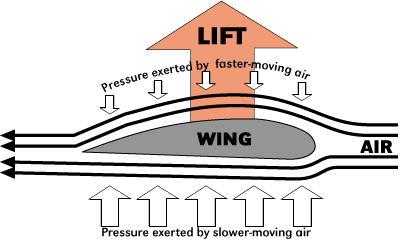Destin from Smarter Everyday just got back from a trip to the jungles of South America to capture some high speed footage of macaws and parrots. He was helping researchers figure out some odd feeding habits caused by a mineral shortage on the western side of the continent. It turns out that the moisture required to sustain the rain forests comes from the Atlantic ocean to the east. By the time it reaches the west coast of South America, the sodium content of the rain has dropped to almost nothing. The macaws and parrots then don’t get enough sodium from the fruit that they eat and have to resort to eating clay.
Of course since Destin is an engineer by trade and nature, he went through the footage to see if he could learn anything about bird flight. When birds glide, their wings have the same foil shape as airplane wings:
The asymmetrical shape causes the airflow to move faster over the top surface of the wing producing a low pressure area. This is already a pretty incredible piece of science, but it only works when there is airflow from the plane or bird’s velocity. Airplanes are able to get up to speed with jet engines and propellers, but what about birds? Well any little kid who has seen a bird fly can tell you that it flaps its wings to say in the air. For a child, that level of understanding is enough. I, for one, do not want to live in a world where everybody only has an elementary understanding of how things work. So what happens when we take a closer look at a flapping bird wing? Contemplating Bernoulli’s Principle on a rigid airplane wing is fairly simple. When the wing becomes jointed, flexible, transient and moving, the mechanics and aerodynamics get more complicated by several orders of magnitude. Check out some of the interesting things that Destin was able to observe in his high speed Macaw footage:
It’s crazy to think about all the amazing things that happen when a bird flaps its wings. There’s a lot going on that keeps the bird in the air as efficiently as possible. The system works so well that small birds are able to do seasonal migrations across entire continents. As humans, we’re just barely beginning to understand how birds fly even though we’ve all but mastered aircraft construction. Researchers have actually started to try and mimic bird flight in an effort to create efficient unmanned flying drones. Check out the Smart Bird prototype from last year’s TED talks:
Who knows, maybe we’ll ride on a flapping wing passenger aircraft one day. I think that would be a pretty amazing and scary experience.
**ADDENDUM May 16th, 2013**
Destin from Smarter Everyday also took the time to make some high-speed footage of bats flying as a response to some of the comments on these bird flight videos. It turns out that bats use the same basic concepts but they don’t need feathers because each of their wings are essentially giant webbed hands with a very high level of articulation. Their higher wing to body mass ratio also allows them to do some pretty impressive aerobatic rotations to perch upside down. Also, somebody is doing their part to promote the robot apocalypse by researching how to make robot bats.
Sources: Smarter Everyday and TED Talks on YouTube

